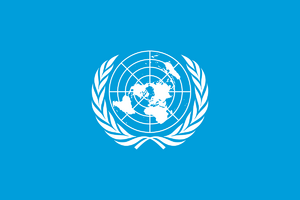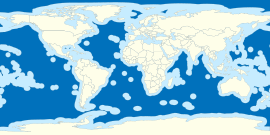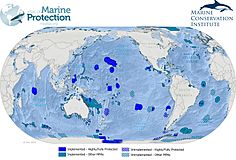High Seas Treaty facts for kids
 |
|
| Type | International legally binding instrument |
|---|---|
| Drafted | 4 March 2023 |
| Signed | Not yet |
The United Nations High Seas Treaty is a legally binding instrument the conservation and sustainable use of marine biological diversity in areas beyond national jurisdiction. It is an agreement under the United Nations Convention on the Law of the Sea (UNCLOS) and is also known as the Biodiversity Beyond National Jurisdiction treaty or the BBNJ treaty. The text was finalised during an intergovernmental conference at the UN on 4 March 2023.
It addresses four themes:
- Marine genetic resources (MGRs), including the fair and equitable sharing of benefits.
- Area-based management tools (ABMTs), including marine protected areas (MPAs).
- Environmental impact assessments (EIAs).
- Capacity building and transfer of marine technology (CB&TMT).
The area-based management tools and environmental impact assessments relate mainly to conservation and sustainable use of marine biodiversity, while the marine genetic resources and capacity building and transfer of marine technology include issues of economic justice and equity.
Before the treaty can enter into force, it needs to be formally adopted at a later UN session and then ratified by at least 60 UN member states. This process is likely to take some time. The former treaty, UNCLOS, was adopted in 1982 and entered into force in 1994. Today, UNCLOS is ratified by 167 states and the European Union; however, some states, including the United States, have yet to sign and ratify it.
Both states and regional economic integration organizations can become parties to the treaty.
Background

The world’s oceans are facing a severe decline in biodiversity and degradation of ecosystems due to threats related to climate change and the expansion of human activities, such as shipping, overfishing, plastic pollution and deep-sea mining. Consequently, there is a pressing need for a more cohesive ocean governance framework, since the existing framework is too fragmented and incomplete to effectively secure conservation and sustainably use of marine biodiversity in areas beyond national jurisdiction. The High Seas treaty aims to address the regulatory gaps.
The areas beyond national jurisdiction compromise the 'high seas' (water column) and the ‘area’ (seabeds), making up about two-thirds of the ocean. The areas are currently regulated by different regional and sectoral agreements, such as regional fisheries management organisations (RFMOs). However, they can only implement measures within their own respective mandate and cooperation is lacking. Additionally, only a few areas are covered, leaving the majority as good as unregulated. The remaining one-third of the ocean falls under national jurisdiction and is situated within the exclusive economic zones (EEZs). The exclusive economic zones extend 200 nautical miles (about 370 km) from the territorial sea baseline. The zones are established under UNCLOS, giving coastal states the jurisdiction over the living and non-living resources within the water and the seabeds.
The negotiations
A new agreement under UNCLOS for areas beyond national jurisdiction has been discussed at the United Nations for almost 20 years. The United Nations began preparatory meetings in 2004 to lay the foundation for an Implementing Agreement to UNCLOS addressing governance and regulatory gaps. On 24 December 2017, the United Nations General Assembly adopted Resolution 72/249 to convene an intergovernmental conference and undertake formal negotiations for a new international legally binding instrument under the UNCLOS for the conservation and sustainable development of marine biological diversity in areas beyond national jurisdiction. Between 2018 and 2023, diplomats have gathered at the UN Headquarters in New York City for negotiating sessions. There have so far been five sessions in total.
During the first session in September 2018, the concept of 'Beyond National Jurisdiction' seemed to have a greater influence on positions taken than the direct concerns regarding 'Biodiversity' itself.
In the second session March/April 2019, it became clear that the principle stating that the new BBNJ agreement "should not undermine" existing institutions could be a hindrance, impeding progress towards achieving an effective instrument.
The third session in August 2019 evolved around the dichotomy between ‘the freedom of the seas’ and ‘the common heritage of mankind’ principles.
The fourth session was originally scheduled for 2020, but it had to be postponed until March 2022 because of the COVID-19 pandemic. During the session, a lack of political will was observed, as states continued to object to substantive, key issues for a new treaty.
The fifth session took place in August 2022 and significant progress was made, but it was not possible to reach consensus on the final treaty text. It was therefore agreed to suspend the session and resume it at a later date. It was resumed in February/March 2023, and the final text was agreed upon, after almost two decades of work. With the words “the ship has reached the shore”, Rena Lee, the president of the intergovernmental conference, announced the final agreement. However, a further resumed fifth session will be held on 19 and 20 June 2023 with a view to adopting the agreement.
The content of the treaty
Marine genetic resources (MGRs), including the fair and equitable sharing of benefits
Marine genetic resources (MGRs), including the fair and equitable sharing of benefits is the first element mentioned in the treaty. Among other things, marine genetic resources can enable production of biochemicals that can be used in cosmetics, pharmaceuticals and food supplements. The economic value of the resources is for now unclear, but the potential for profits has created an increased interest in the resources exploration and exploitation among stakeholders.
During the UN negotiations it has been a contentious point whether or not marine genetic resources should apply to ‘fish’ and ‘fishing activities’. If not, it would be likely to impact the ability of the High Seas treaty to address its objective, since fish are a major component of marine biodiversity and play an essential role in the functioning of marine ecosystems, according to some experts. However, the final treaty text states that the provisions about marine genetic resources do not apply to ‘fish’ and ‘fishing’ in areas beyond national jurisdiction.
The part about fair and equitable sharing of benefits has also been a point of dispute in the negotiations. In the end it was agreed upon to regulate non-monetary as well as monetary benefits. Furthermore, an access and benefit-sharing committee will be established with the purpose of providing guidelines for the benefit-sharing, and ensuring that this is done in a transparent, fair, and equitable way.
Area-based management tools (ABMTs), including marine protected areas (MPAs)
Area-based management tools (ABMTs), including marine protected areas (MPAs) are recognized as key tools for conserving and restoring biodiversity. They can be used to protect, preserve and maintain certain areas beyond national jurisdiction. Marine protected areas offer a degree of long term conservation, and are already established in some areas. However, the protection level of biodiversity varies a lot and the protected areas only cover a small proportion of the areas beyond national jurisdiction. Area based management tools can be used for short-term and emergency measures and to address a specific sector.
The process to establish a tool or a protected area is as follows. First, a part under the High Seas treaty has to submit a proposal for an area-based management tool or a marine protected area. The proposal has to be based on the best available sciences and information. It will be made publicly available and transmitted to the Scientific and Technical Body to be reviewed. Hereafter, relevant stakeholders have to be consulted. The proposal has to be adopted by consensus - or if this is not possible, three-quarter majority of the representatives present and voting. The decision will enter into force within 120 days after the voting, and will be binding for all parties of the treaty. However, if a part within the 120 days makes an objection to the decision, an opt-out is possible.
After the treaty text was finalised, it has been reported that the treaty through marine protected areas will protect 30 pct. of the oceans by 2030 - a target adopted at the UN Biodiversity Conference (COP15) in December 2022 - however this is not the case, according to experts. The treaty can help to implement the 30 by 30 biodiversity target in the oceans, but it will a require a lot of action by states.
Environmental impact assessments (EIAs)
Environmental impact assessments have the potential to predict, reduce and prevent human activities affecting marine biodiversity and ecosystems. While the institutional and legal framework for environmental impact assessments is well established in areas within national jurisdiction, it is less developed in areas beyond. Under the treaty, participating parties are obliged to conduct environmental impact assessments when a planned activity may have an effect on the marine environment, or when there is insufficient knowledge about its potential effects. In such cases, the party possessing jurisdiction or control over the activity is required to conduct the assessment.
The treaty also includes provisions for Strategic Environmental Assessments (SEAs), which are assessments that are more holistic and focused on long-term environmental protection compared to the more specific focus of environmental impact assessments. Parties under the treaty have to consider conducting a strategic environmental assessment for plans and programmes related to their activities in areas beyond national jurisdiction, but are not obliged to conduct one.
Capacity building and the transfer of marine technology (CB&TMT)
Capacity building and the transfer of marine technology concerns the equitable access to research conducted in international waters and enabling cooperation and participation in the activities outlined in the agreement. Different types of capacity building and transfer of technology are mentioned in the agreement, such as sharing of information and research results; develop and share manuals, guidelines and standards; collaboration and cooperation in marine science; and develop and strengthen institutional capacity and national regulation or mechanisms.
Technology plays an important role in the implementation, making capacity building and technology transfer essential for the enforcement of the treaty. A key focus is to support developing and geographically disadvantaged states in implementing the agreement.
Furhtermore, a capacity-building and transfer of marine technology committee will be established, in order to motor and review the undertaken initiatives, under the authority of the Conference of the Parties.
Institutional Setup
The treaty introduces a new institutional framework in part VI about ‘Institutional Arrangements’, including the Conference of the Parties, the Scientific and Technical Body, the secretariat and the clearing-house mechanism.
The Conference of the parties (COP) will have its first meeting one year after the treaty enters into force, at the latest. The rules of procedure and the financial rules will be adopted at the first meeting. The Conference of the Parties will review and evaluate the implementation of the High Seas treaty. The Conference has to take decisions and adopt recommendations by consensus - or if it is not possible to reach consensus after all efforts have been exhausted, adopted by a two-thirds majority of the parties present and voting. The Conference will also have to promote transparency in the implementation of the agreement and the related activities. Five years after the treaty enters into force, the Conference of Parties has to review the treaty.
The Scientific and Technical Body will be composed of members nominated by the parties and elected by the Conference of the Parties, serving as experts and in the best interest of the agreement. The need for multidisciplinary expertise has to be taken into account in the nomination and election of members. The Scientific and Technical Body will among other things provide scientific and technical advice to the Conference of the Parties, monitor and review area-based management tools and comment on environmental impact assessments.
The secretariat is responsible for providing administrative and logistical support to the Conference of the Parties and its subsidiary bodies. This includes tasks, such as arranging and servicing the meetings, as well as circulating information relating to the implementation of the treaty in a timely manner.
The clearing-house mechanism will work as an open-access platform, facilitating the access, provision, and dissemination of information. It will promote transparency and facilitate international cooperation and collaboration. The mechanism will be managed by the secretariat.
In addition, the treaty establishes an ’access and benefit-sharing committee’, a ‘capacity-building and transfer of marine technology committee’, a ‘finance committee on financial resources’ and an ‘implementation and compliance committee’. However, these are not mentioned in the section about institutional arrangements.


